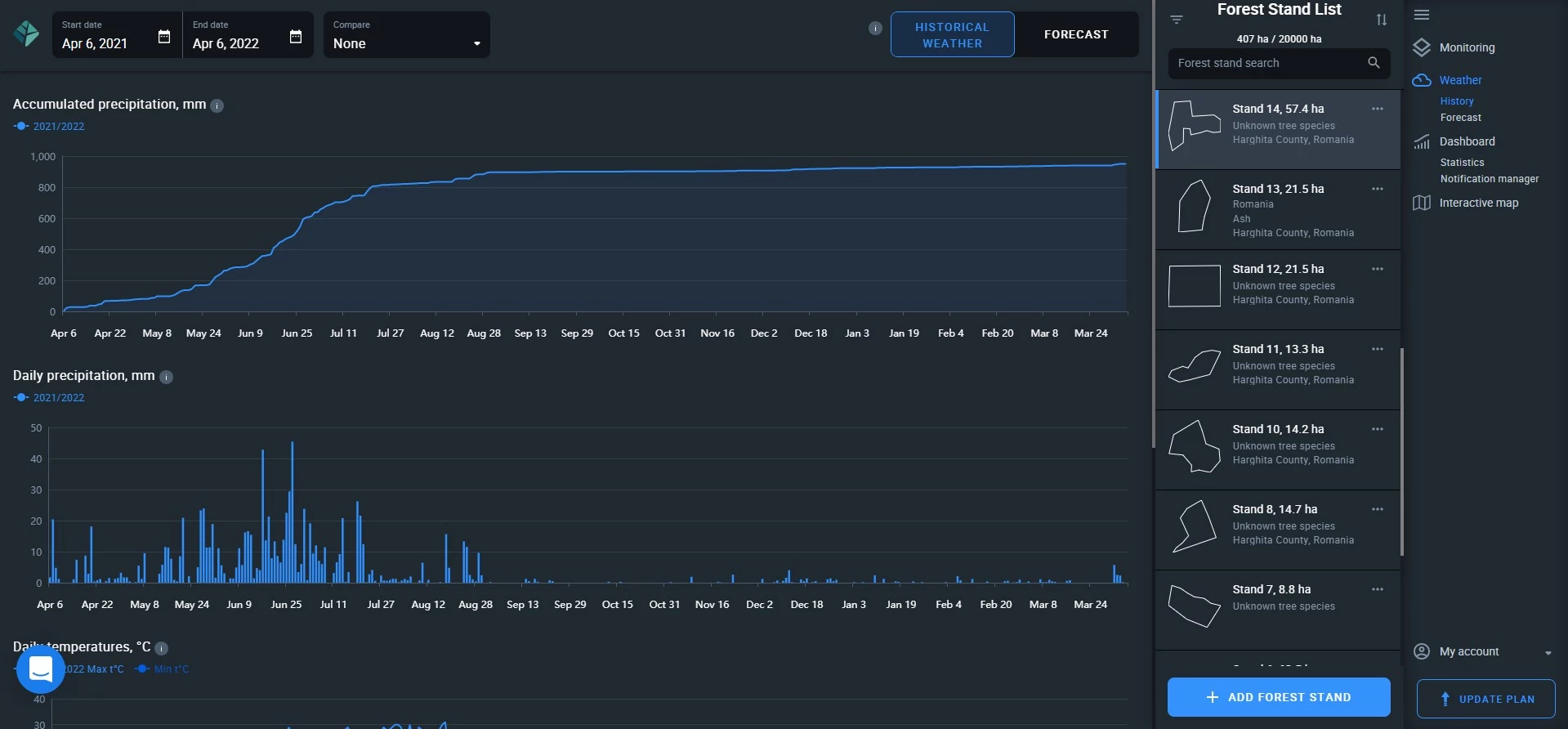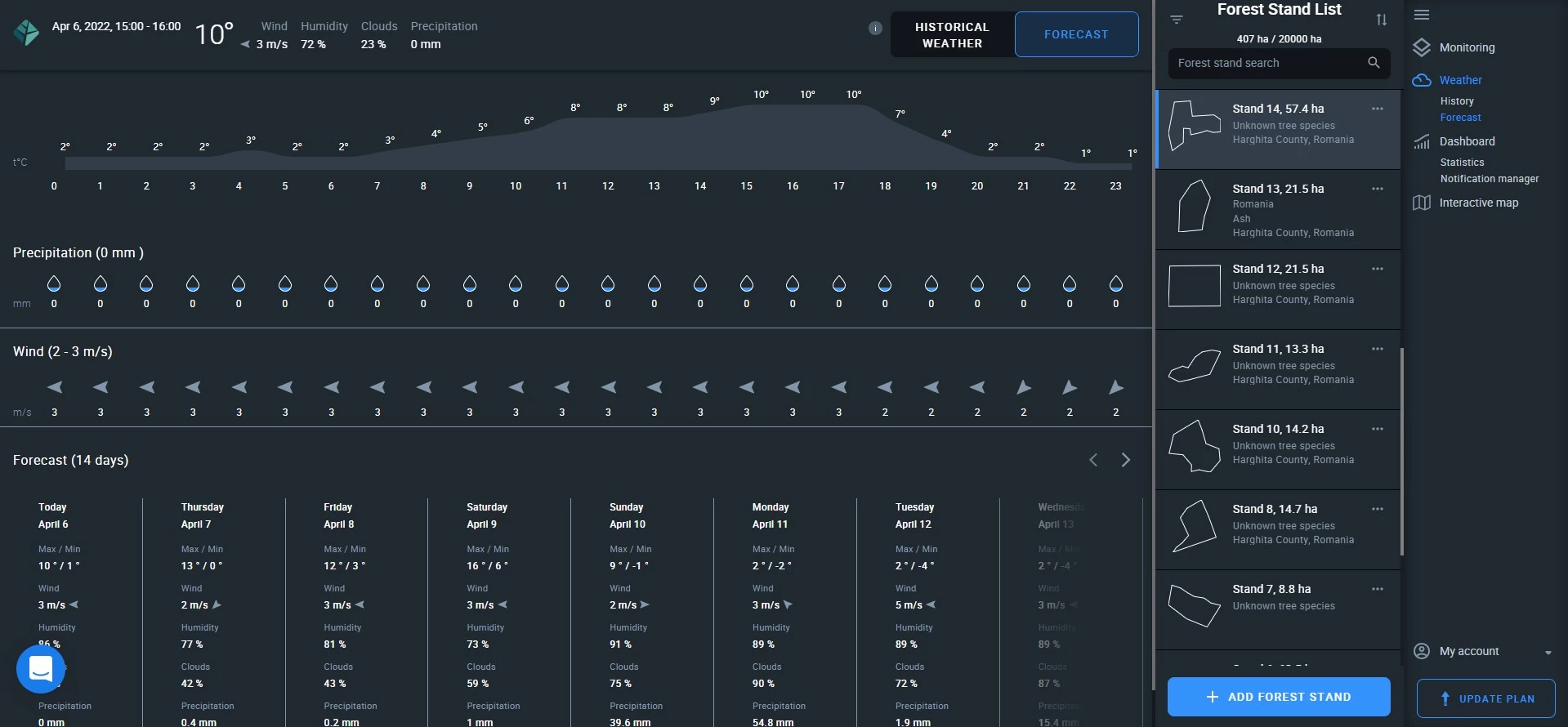Use the Weather tab to better understand how suitable the climate is for the growth of different species of trees in your area of interest. The tab will help you estimate the vegetation periods for different tree species, as well as the amount of precipitation within the areas of interest (your forest stands).
In this tab, you can get access to:
- historical weather data collected since 2008 for all of your areas of interest;
- current weather data;
- 24-hour forecast;
- 14-day weather forecast.
Historical Weather
This section provides you with the data on the key weather parameters for a specific area of interest, and for any period that you have selected*, in a graph format.

For now, we provide data on:
- Accumulated precipitation
- Daily precipitation
- Daily temperatures
- Sum of active temperatures
*At the moment, the maximum historical weather period you can select is 5 years.
How To Select A Historical Weather Period
On the upper bar, you see Start date, End date, and the Compare box.
- By clicking on the small calendar icon inside the Start date box, you open a calendar where you can select the year, month, and date.
- Once you click on the date, the calendar window will automatically close.
- Now, the Start date box will show you the date, month, and year you have selected.
Simply repeat these steps for the End date box, and, once you have both dates, the historical weather period has been selected.
Now let’s take a closer look at each historical weather parameter.
Accumulated Precipitation
This graph shows the amount of accumulated precipitation over a selected period. Water is an essential element in assimilation, dissimilation, gas exchange, and other natural biochemical processes. Water stress affects tree growth and leads to lower productivity. Use this graph to improve irrigation efficiency and increase forest productivity as a result.
Daily Precipitation
The graph shows the amount of daily precipitation on a selected forest stand. Rain and snow provide plants with moisture, nitrate salts, ammonia, and other minerals. Snow cover protects young plants from low temperatures and mechanical damage, as well as prevents frost from penetrating soil too deeply while letting meltwater permeate the soil. Too much snow, on the other hand, can cause a snow break – damage to the trees.
Daily Temperatures
On this graph, you can view the history of maximum and minimum daily temperatures on the forest stand. It allows you to analyze forest fire trends and get a better grip on the growing season time frame (start and end dates), as well as study extreme temperature trends. Use this data to make well-informed decisions to mitigate fire risks in a timely manner.
Sum Of Active Temperatures
The graph displays the sum of active temperatures for the selected forest stand. It allows you to analyze forest microclimate, determine whether this particular forest stand is suitable for planting certain tree species, and estimate the length of a growing season.
Compare
In order to better understand the weather patterns or trends for a given area of interest, you can compare data for a selected period on all of the graphs with the 5-year average data. For example, if you would like to see the history of daily precipitation on your forest stand for the past year, you could compare it with the 5-year average precipitation figure. Here’s what you need to do:
On the upper bar, there is a Compare box that is set to “None” by default.
Go ahead and click on the box and select “5 Years average”. It may take a few seconds for the graphs to adjust. Once it’s done, precipitation data for the past year will be displayed as blue vertical bars, while the 5-year average data will be in orange for contrast.
Forecast
In the Forecast tab, you will be able to check:
- current temperature,
- wind speed and direction,
- humidity percentage,
- cloudiness percentage,
- and precipitation in mm or inch.
Below, there is a 24-hour forecast that contains data on:
- hourly temperatures,
- precipitation in mm or inch,
- and wind data.
At the bottom, we display the 14-day weather forecast provided by our partner. It contains data on:
- max/min temperatures,
- wind speed and direction,
- humidity percentage,
- cloudiness percentage,
- and precipitation in mm or inch.
